Efficacy of Diet Recommended at Naturopathy Centers on the Weight Reduction among Essential Hypertensive Patients
Nutan
Assistant Professor, Department of Food and Nutrition
Bhagat Phool Singh Mahila Vishvavidyalaya, Khanpur Kalan, Haryana, India
Email: drnutan@gmail.com
Introduction
Hypertension, a curse of modern society is the precursor of several cardiovascular disorders and gives birth to fatal coronary lesions if not treated well in time. Hypertension may be cropped up as a result of sedentary life style, excessive alcoholism, smoking, overeating and fast pace of tension loaded life.Normally changes in life are the golden rule in the prevention and even cure of such ailments. Naturopathy completely and successfully encompasses all these factors i.e. it attacks all culprits responsible for hypertension. The consumption of snacks, with the fatty and salty content or the intake of fast food is associated with the increased prevalence of hypertension, mainly among the socio-economically under privileged groups, who usually consume such types of food.
Gupta et al (2017) reported that hypertension is present in 25-30 per cent of urban and 10-20 per cent of rural subjects in India. Approximately half of two-thirds of these are stage-1 hypertension (systolic BP 140-159 mm Hg or diastolic BP 90-99 mm Hg). Along with smoking, obesity is thought to be the first preventable cause of death. Obesity is a traditional risk factor for cardio vascular diseases and it is well correlated with insulin resistance and hyperglycemia. Davidson (1980) considers that naturopathy removes ill health altogether by living according to the laws of nature. Naturopathy and yoga (an Indian system of medicine which emphasizes on lifestyle changes to prevent and cure diseases) may be well positioned to offer structured lifestyle interventions due to low technological input required, moderate cost and better patient acceptability to traditional system of medicine. In India, various naturopathy centres have been set up for treating the patients suffering from hypertension and heart related diseases. Therefore, the present study has been taken with the objective to assess the role of naturopathic lifestyle in reducing the weight of subjects as maintenance of body weight within normal limits helps to control the blood pressure
Materials and Methods
Thirty hypertensive males and equal number of hypertensive females who enrolled themselves in naturopathy centres (Prakritik Jeevan Kendra, Pattikalyana, G.T. Road, Panipat, Haryana and Navneet Prabhakar Yog Chikitsa Dham, Bassi, Jaipur, Rajasthan) for the treatment of hypertension were selected. Thesubjects were between the age group of 40-60 years and were undergoing treatment for the last one month in naturopathy centres. They used to perform yoga (exercise and pranayama) in naturopathy centres. Along with this, they had undergone mud, water and diet therapies accordingly. They used to drink herbal tea, honey amla water or bottle guard juice in fasting state according to their complications.
Meal pattern and intake of each subject as before and after attending the naturopathy centre for one month for treatment were established by 24 hour recall method for three consecutive days. Total amount of raw and cooked food in the family was also noted during this duration. Based on the above data, the amount of raw food consumed by each subject was calculated as follows:

Their nutrient intake was compared with the Recommended Dietary Allowances given in Nutritive Value of Indian Foods (Gopalan 1992). Plenty of seasonal fruits and controlled fluid intake was recommended. They took bottle guard juice in fasting state and then herbal tea after 2 hours of it. They were provided cow milk once a day.
Height, weight, waist and hip circumference of each subject was measured by using the method of Jeliffe (1996) before and after naturopathic treatment. BMI and WHRwere calculated before and after the treatment of each subject by using the method given by James et al (1988) and Wardlaw et al (2012), respectively as follows:
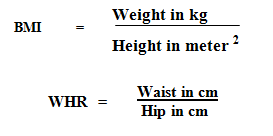
The subjects were graded as per normal values and standardized tables.
Data for height, weight, and BMI, WHR and lipid profile were statistically analyzed and paired‘t- test’ was used for calculating difference of significance.
Results and Discussion
Anthropometry
At the time of joining naturopathy centre, all anthropometric parameters were above the ICMR standards
Body weight: Mean weight of the male and female subjects was 71.29 and 67.02 kg at the time of joining naturopathy center which decreased to 65.03 and 59.76 kg respectively after joining naturopathy centers (Table1).
Basal metabolic index: Mean BMI of male and female subjects was 25.16 and 28.07 respectively at the time of joining naturopathy center (Table 1). Analysis of data further reveals that before joining the naturopathy center, maximum subjects were at the risk of obesity and were the 1stcategory and 2ndcategory obese. BMI of 6.6 per cent of subjects was below normal (<18.5) whereas 16.6 percent of subjects had normal BMI range (18.5 to 22.9) (Table 2). Before diet intake at naturopathy centers, the mean values of BMI in the essential hypertensive observation group of males, females and total were 25.16+3.95, 28.07+5.92 and 26.74+ 5.22 kg/m2 respectively which declined to 23.66+3.72, 26.16+5.05 and 25.02+4.58 kg/m2 after 15 days and further went down to 22.95+3.60, 25.07+4.68 and 24.10+4.28 kg/m2 respectively after 30 days of naturopathic diet intake (Table 1).
Table 1: Anthropometric Parameters of the Hypertensive Human Subjects at Joining (A), After 15 Days (B) and After 30 Days (C) of Naturopathic Treatment
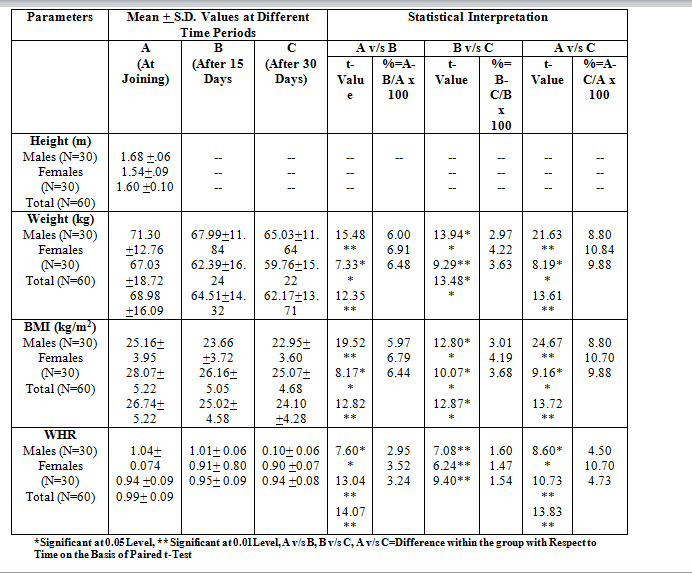
Waist hip ratio: Prior to admission at naturopathy centers, the WHR of male and female subjects was 1.04+0.07 and 0.94+0.09, respectively which decreased to 1.01+ 0.06 and 0.91+ 0.08 after 15 days to 0.99+0.05 and 0.90+0.07 after 30 days (Table 1 & Table 3). The reduction in both the anthropometric parameters was significant at both levels (P >0.01) at all points of the study. However, a major chunk of subjects who were the victims of obesity, reported to have a feeling of fitness after joining naturopathy center. The percentage of subjects who had below normal weight increased from 6.6 per cent to 13.33 per cent, which is beneficial for better blood pressure control (Table 2). Initially 16.6 percent of subjects were under the normal BMI category (18.5-24.9), which increased up to 23.32 per cent after one month of treatment. This is due to summative effect of vegetarian diet, yogasana and pranayam. Hence naturopathic treatment was found effective in reducing the BMI of obese subjects.
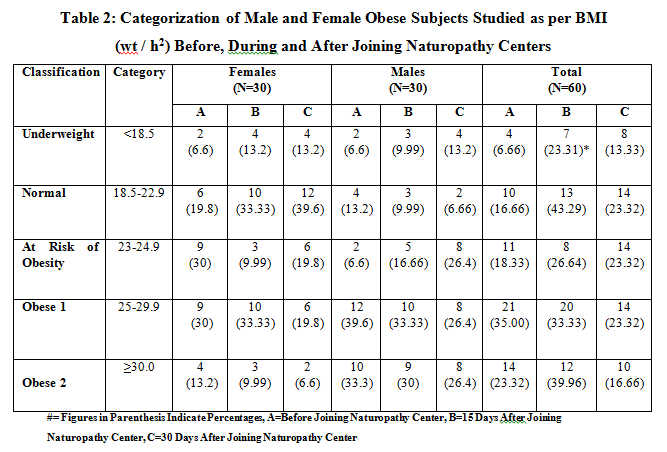
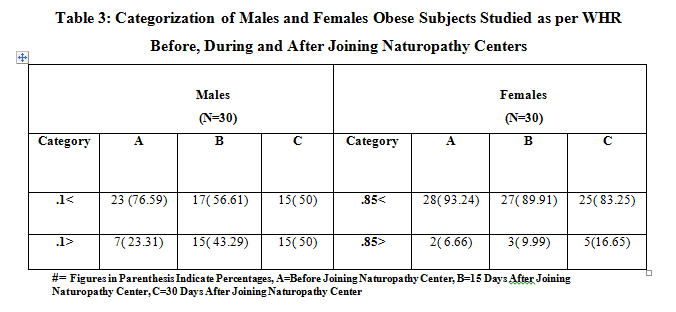
Nutrient Intake
Before attending naturopathy center, mean intake of energy (kcal), protein (gm), fat (gm), carbohydrates (gm), vitamin A(mg), vitamin C (mg), calcium (mg), iron (mg), fiber (gm), sodium (mg), and potassium (mg) was 2621.30+ 73.21, 102.35+ 13.94, 49.05+ 5.70, 361.28+63.12, 358.9+44.15, 66.14+17.73, 678.33+50.21, 16.52+6.13, 10.48+7.14, 1419.99+100.21, and 1400.85+114.21 in male subjects and corresponding intake in female subjects was 1982.34+ 84.72, 48.33+ 11.23, 40.54+ 8.15, 281.63+ 53.61, 310.86+ 35.67, 44.88 +13.52, 281.02 + 65.14, 13.06 + 4.45, 9.08 + 4.34, 1370.49 +92.71, and 1353.99 +123.22 (Table 4).
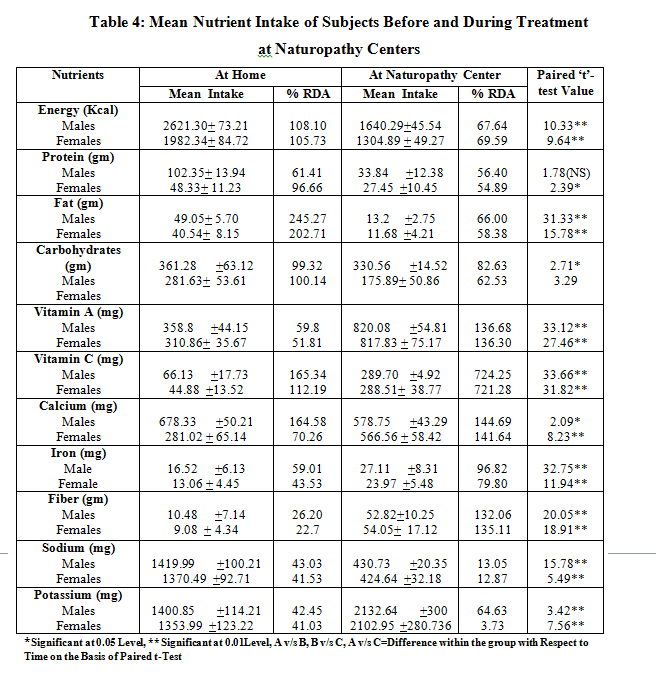
The mean intake of energy, carbohydrate, fat and vitamin C was more than RDA and protein, fiber, vitamin A, iron, sodium and potassium was below RDA before attending naturopathy center. However during treatment in naturopathy center, the intake of food condensed in energy was reduced but fruits and vegetable intake by both male and female had increased the vitamin C intake by six folds. Calcium intake was below RDA for female subjects and above RDA for male subjects but was above required level at naturopathy center. Increased Iron intake supported by high vitamin C in the diet of all subjects has enhanced the hemoglobin level in all subjects. Due to increased intake of antioxidant nutrients like vitamin C, fiber and carotene, hypocholestrolemic effect was evident from the collected data. Fiber intake had increased nearly twice.
Conclusion
Results of the present study advocate food therapy in naturopathy center treatment as reliable tool for effective weight reduction and blood glucose regulation by changing the food habits and incorporation of healthful food stuffs in the dietary pattern.
References
Amrithveni M and Thirumanidevi MA (2004) Effect of Supplementation of Fenugreek Seeds for NIDDM Patients. The.Ind.J.Nutr.Dietet (41): 139-145.
Bandaranaike S (2004) Detoxifying the Body with Naturopathy Diet, Hydrotherapy and Herbs. Positive Health Magazine, Bombay.
Chakarvorty N (1990) A Hand Book of Natural Treatment. Calcutta: Prakritic Chikitsalay: 87
Davidson S (1980) A Popular Guide to Nature Cure. Bombay: DP Taraporewala Sons & Co.Ltd:10-16.
Dewan AP (1998) Food for Health. New Delhi: M/S AC Specialist Publishers Pvt. Ltd: 8, 24, and 27.
Gopalan C, Ramashastri BV, and Balasubramaniam SC (1992) Nutritive Value of Indian Foods. Hyderabad: National Institute of Nutrition ICMR.
Gupta R and Gupta S (2017) Hypertension in India: Trends in Prevalence, Awareness, Treatment and Control. Journal of Health Sciences 2(1).
Gupta S (1998) A Short Text Book of Medical Laboratory for Technicians. New Delhi: Jaypee Brothers Medical Publishers (P) Ltd: 128,197,200.
Hagander B (1988) Dietary Fiber Decreases Blood Glucose Level and Plasma LDL Concentration in NIDDM Patients. Am. J. Cli. Nutr (47): 852-858.
Hagander B (1988) Dietary Fiber Decreases Blood Glucose Level and Plasma LDL Concentration in NIDDM Patients. Am. J. Cli. Nutr (47): 852-858.
James WPT, Mascie T, Norgan NG, Bristrian BR, Shetty P, and Ferro LA (1994) The Value of Arm Circumference Measurements in Assessing Chronic Energy Deficiency in Third World Adults. Eur J Clin Nutr (48): 883-894.
Jelliffe DB (1996) The Assessment of Nutrition Status of the Community. World Health Organization Monograph Series No. 53, Geneva: 50-84.
Jindal SR (1996) Nature Cure a Way of Life. Bangalore: Institute of Naturopathy and Yogic Sciences: 3, 5, 16-30.
Johanna T (1988) Health Aspects of Vegetarian Diets. Am. J.Clin.Nutr (48): 712- 738.
Khanna K, Gupta S, and Jain P (1997) Nutrition and Dietetics. New Delhi: Phoenix Publishing House Pvt. Ltd: 288-316.
Mangeshwari, Joseph U, and Minitha S (2004) Pattern of Cardiovascular Complications among Diabetics. The.Ind.J.Nutr.Dietet (41):507-513.
Sharma S (1993) Practical Biochemistry. Jaipur: Classic Publishing House: 202, 218, 241, 242.
Singh T, Sharma S, and Seetharamiah N (2017) Social- economic Scales Updated for 2017. International Journal of Research in Medical Sciences 5(7): 3264-3267.
Srinivas RE, Kumar AMV, Srinivas B, Manthena SR, and Gupta V (2016) Integrated Naturopathy and Yoga Reduces Blood Pressure and the Need for Medications among a Cohort of Hypertensive Patients in South India-3 Month Follow up Study. Advances in Integrative Medicine 3:90-97.
Theodora P, George H, Nikolaos P, Emmanuel A, Alexandros B, and Dimitris T (2017) Socio-economic Status and Risk Factors for Cardiovascular Diseases: Impact of Dietary Mediators. Hellenic Society of Cardiology (58): 32-42.
Thimmayamma BVS and Rao P (1996) A Text Book of Human Nutrition. New Delhi: Oxford and IBH Publishing Company Pvt. Ltd: 125-135.
Wardlaw JM, Murray V, Berge E, Del ZG, Sandercock P, and Lindley RL (2012) Recombinant Tissue Plasminogen Activator for Acute Ischemic Stroke: An Updated Systematic Review and Meta-Analysis. Lancet 379: 2364–72.
World Health Organization (2014) Global Status Report of Non Communicable Diseases. Geneva: World Health Organization.

